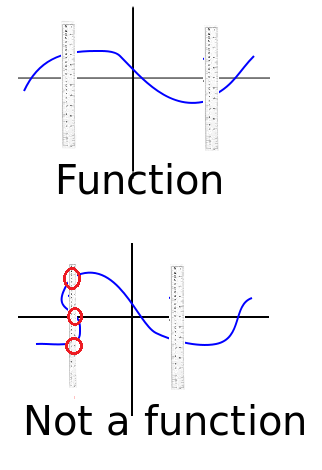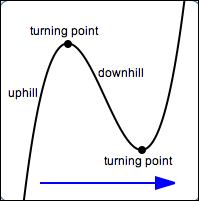Intro to functions
Functions are a way of describing a special relationship between an input and an output variable.
It is like a set of rules for how to transform a number.
It is mainly written as f(x), such that x is the input vairable.

Plotting a function
if the input variable represents the x-axis and the output the y axis of a coordinate plane then a function can be plotted on a graph. To do this by hand plot a 4-5 points on the graph and then join them with a smooth line.

Vertical line test
A function takes a single input and give a single output. If there is more than one outcome the equation is not a function.
To test if an equation is a function, you can perform the verticla line test. To do this graph the function and move a vertical line, such as a ruler horizontally across the graph. If the vertical line touches more than one point, then these points share the same input and it is not a function. If no two points touch the vertical line at the same time the equation has passed the test and is a function

Terms to describe functions
|
Term
|
Examples
|
Definition
|
| Monomial |
2x, m, 3, |
A number, a variable or a product of numbers and variables. |
| Polynomial |
2x+5, k2+8 |
Any function that connects coefficents and variables only with the operations of multiplicaiton, devison, addition and subtraction. |
| Degree of a polynomial |
x4+3x2-2x |
The greatest exponent in a function with a variable base. |
| Leading Coefficient |
3x, |
Coefficient of the term with the highest exponent. |
| Turning Point |
 |
A point on a graph where the gradient changes from positive to negative or from negative to positive. |
Families of Functions
| Name of function |
General form |
Example |
Characteristics |
| Linear |
ax+b |
2x -1 |
The highest power/exponent of any variable in the function is 1. |
| Quadratic |
ax2+bx+c |
x2 + x -5 |
The highest power/exponent of any variable in the function is 2. |
| Cubic |
ax3+bx2+cx+d |
4x^3 -x^2 |
The highest power/exponent of any variable in the function is 3. |
| Rational |
|
|
Devision is used as an operator |
| Exponential |
|
f(x)=2^(x-1) -5 |
There is a variable in the exponent. |
| Logarithmic |
|
f(x)=log(2x-3) |
It has a log in it. |
| Trigonometric |
|
f(x)=Cos(x) |
It has a trigonometric ratio in it. |
Linear functions
Function
m = determines the gradient/steepness of the line
c = changes y-intercept
x = input number
Functions for parallel and perpendicular lines
Parallel Lines: have same gradient but different y-intercepts
Perpendicular line: has a negative and flipped gradient (this also affect and determines the y-intercepts)
Exponential Functions
Function
a= Determines reflection on x-axis
b= Changes the gradient/steepness of the line
c= Transforms the line on the x-axis
d= Changes horizontal asymptote and y-intercept
x= Input number
z= Determines reflection on y-axis.
Domain and Range
Definition: The domain is the restrictions of the x values.
E.g. Domain is: x > 0, x € ℝ
Range
The set of all possible outputs of a function (z-values on the graph) is called the range of a function.
E.g: Range is: 1 < y < 3, y = ℝ
Things that restrict the Domain and range:
- You cannot divide by zero.
- You cannot take the square root of a negative number.
- You cannot take the logarithm of a negative number or zero.
Transforming functions
Sin, Cos functions
Basic structure of the functions:
f(x)=a(x-h)2+k
f(x)=asin (bx)+c
Editors- Cerita - 390 words.
- joeClinton - 273 words.
View count: 10634